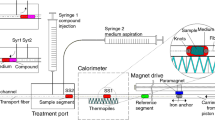Summary
In 20 cats anaesthetized with alpha-chloralose and spinalized at the thoracolumbar junction we investigated the role of stimulation induced accumulation of extracellular potassium in the spinal cord in the processing of nociceptive discharges from the knee joint. For that we electrically stimulated the posterior articular nerve of the knee. We further performed innocuous and noxious stimulation of the knee and of other parts of the leg and studied the effect of an acute inflammation of the knee on [K+]0 in the spinal cord. Innocuous stimulation of the skin (brushing or touching) and innocuous movements in the knee joint all induced rises in [K+]0 which were maximal at recording depths of 1500 to 2200 μm below the surface of the cord dorsum. Peak increases were 0.4 mM for touching the leg and 1.7 mM during rhythmic flexion/ extension of the knee joint. Noxious stimulation of the skin, the paw, the tendon and noxious movements of the knee joint also produced rises in [K+]0, which were somewhat larger for the individual types of stimuli than those produced by innocuous intensities. Electrical stimulation of the posterior articular nerve induced rises in [K+]0 by up to 0.6 mM. Stimulus intensities sufficient to activate unmyelinated group IV fibers were only slightly effective in raising [K+]0 above the levels reached during stimulation of myelinated group II and III fibers. During development of an acute inflammation of the knee joint (induced by kaolin and carrageenan), increases in [K+]0 and associated field potentials became larger by about 25%. We assume that this reflects an increase in neuronal responses. In conclusion, changes in [K+]0 in the spinal cord are some-what larger during noxious stimulation than during innocuous stimulation. The absolute level reached depended more on the site and type of stimulation than on the actual stimulus intensity itself. Hence a critical role of spinal K+ accumulation for nociception is unlikely.
Similar content being viewed by others
References
Craig AD, Heppelmann B, Schaible HG (1988) The projection of the medial and posterior articular nerves of cat's knee to the spinal cord. J Comp Neurol 276: 279–288
Czeh G, Kriz N, Sykova E (1981) Extracellular potassium accumulation in the frog spinal cord induced by stimulation of the skin and ventrolateral columns. J Physiol (Lond) 320: 57–72
Dietzel I, Heinemann U (1986) Dynamic variations of the brain cell microenvironment in relation to neuronal hyperactivity. Ann NY Acad Sci 481: 72–86
Dietzel I, Heinemann U, Hofmeier G, Lux HD (1980) Transient changes in the size of the extracellular space in the sensorimotor cortex of cats in relation to stimulus induced changes in potassium concentration. Exp Brain Res 40: 432–439
Freeman MAR, Wyke B (1967) The innervation of the knee joint: an anatomical and histological study in the cat. J Anat 101: 502–532
Gutnick MJ, Heinemann U, Lux HD (1979) Stimulus induced and seizure related changes in extracellular potassium concentration in cat thalamus (VPL). Electroencephalogr Clin Neurophysiol 47: 329–344
Guilbaud G, Kayser V, Benoist JR, Gautron M (1986) Modifications in the responsiveness of rat ventrobasal thalamic neurons at different stages of carrageenan-produced inflammation. Brain Res 385: 86–98
Heinemann U, Gutnick MJ (1979) Relation between extra-cellular potassium concentration and neuronal activities in cat thalamus (VPL) during projection of cortical epileptiform discharge. Electroencephalogr Clin Neurophysiol 47: 345–357
Heinemann U, Lux HD, Gutnick MJ (1977) Extracellular free calcium and potassium during paroxysmal activity in the cerebral cortex of the cat. Exp Brain Res 27: 237–243
Heinemann U, Lux HD, Marciani MG, Hofmeier G (1979) Slow potentials in relation to changes in extracellular potassium activity in the cortex of cats. In: Speckmann EJ, Caspers H (ed) Origin of cerebral field potentials. Thieme, Stuttgart, pp 33–48
Kriz NE, Sykova E, Ujec E, Vyklicky L (1974) Changes of extracellular K+ concentration induced by neuronal activity in the spinal cord of the cat. J Physiol (Lond) 228: 1–15
Kriz NE, Sykova E, Vyklicky L (1975) Extracellular potassium changes in the spinal cord of the cat and their relation to slow potentials, active transport and impulse transmission. J Physiol (Lond) 249: 167–182
Krnjevic K, Morris ME (1975) Correlation between extracellular focal potentials and K+ potentials evoked by primary afferent activity. Can J Physiol Pharmacol 53: 912–922
Kuffler SW, Nicholls JG, Orkand RK (1966) Physiological properties of glial cells in the central nervous system of amphibia. J Neurophysiol 29: 768–787
Langford LA, Schmidt RF (1983) Afferent and efferent axons in the medial and posterior articular nerves of the cat. Anat Rec 206: 71–78
Lewis DV, Schuette WH (1976) NADH fluorescence, [K+]0 and oxygen consumption in cat cerebral cortex during direct cortical stimulation. Brain Res 110: 523–535
Lothmann EW, Somjen GG (1975) Extracellular potassium activity, intracellular and extracellular potential responses in the spinal cord. J Physiol (Lond) 252: 115–136
Lux HD (1974) Fast recording ion specific microelectrodes: their use in pharmacological studies in the CNS. Neuropharmacology 13: 509–517
Lux HD, Neher E (1973) The equilibration time course of [K+]0 in cat cortex. Exp Brain Res 17: 190–205
Nicholson C (1980) Dynamics of the brain cell microenvironment. MIT Press, Cambridge MA, p 322
Perl ER (1984) Pain and nociception. In: Brockhart JR, Mountcastle VB (eds) Handbook of physiology, Sect 1. The nervous system, Vol III. Sensory processes, Part II. Am Phys Soc, Bethesda MD, pp 915–975
Sato Y, Schaible H-G, Schmidt RF (1983) Types of afferents from the knee joint evoking sympathetic reflexes in cat inferior cardiac nerves. Neurosci Lett 39: 71–75
Schaible H-G, Schmidt RF (1985) Effects of an experimental arthritis on the sensory properties of fine articular afferent units. J Neurophysiol 54: 1109–1121
Schaible H-G, Schmidt RF (1988a) Direct observation of the sensitization of articular afferents during an experimental arthritis. In: Dubner R, Gebhart GF, Bond MR (eds) Proceedings of the Vth world congress on pain: pain research and clinical management, Vol 3. Elsevier, Amsterdam, pp 44–50
Schaible H-G, Schmidt RF (1988b) Time course of mechano-sensitivity changes in articular afferents during a developing experimental arthritis. J Neurophysiol 60: 2180–2195
Schaible H-G, Schmidt RF, Willis WD (1986) Responses of spinal cord neurones to stimulation of articular afferent fibers in the cat. J Physiol (Lond) 372: 575–593
Schaible H-G, Schmidt RF, Willis WD (1987a) Convergent inputs from articular, cutaneous and muscle receptors onto ascending tract cells in the cat spinal cord. Exp Brain Res 66: 479–488
Schaible H-G, Schmidt RF, Willis WD (1987b) Enhancement of the responses of ascending tract cells in the cat spinal cord by acute inflammation of the knee joint. Exp Brain Res 66: 489–499
Somjen GG (1973) Electrogenesis of sustained potentials. Prog Neurobiol 1: 199–237
Somjen GG (1979) Extracellular potassium in the mammalian central nervous system. Annu Rev Physiol 41: 97–177
Sykova E (1983) Extracellular K+ accumulation in the central nervous system. Prog Biophys Mol Biol 42: 135–189
Sykova E, Czeh G, Kriz N (1980) Potassium accumulation in the frog spinal cord induced by nociceptive stimulation of the skin. Neurosci Lett 17: 253–258
Ten Bruggencate G, Lux HD, Liebl L (1974) Possible relationships between extracellular potassium activity and presynaptic inhibition in the spinal cord of the cat. Pflügers Arch 349: 301–317
Vyklycky L, Sykova E, Kriz N (1975) Slow potential induced by changes of extracellular potassium concentration in the spinal cord of the cat. Brain Res 87: 77–80
Woolf CJ (1983) Evidence for a central component of post-injury pain hypersensitivity. Nature 306: 686–688
Author information
Authors and Affiliations
Rights and permissions
About this article
Cite this article
Heinemann, U., Schaible, H.G. & Schmidt, R.F. Changes in extracellular potassium concentration in cat spinal cord in response to innocuous and noxious stimulation of legs with healthy and inflamed knee joints. Exp Brain Res 79, 283–292 (1990). https://doi.org/10.1007/BF00608237
Received:
Accepted:
Issue Date:
DOI: https://doi.org/10.1007/BF00608237




